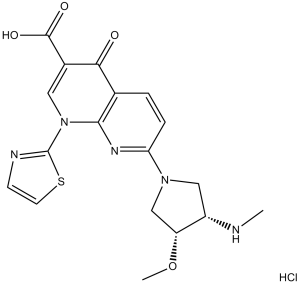This product is for research use only, not for human use. We do not sell to patients.

| Size | Price | Stock |
|---|---|---|
| 100mg | $1050 | Check With Us |
| 250mg | $2050 | Check With Us |
| 500mg | $3075 | Check With Us |
Cat #: V1396 CAS #: 175519-16-1 Purity ≥ 98%
Description: Voreloxin HCl (formerly known as AG-7352; SNS-595; SPC 595; AG 7352; SNS595, AG-7352; Vosaroxin), the hydrochloride salt of Voreloxin which is a naphthyridine analog, is a novel and potent Topoisomerase II inhibitor with a broad-spectrum antineoplastic activity.
Publications Citing InvivoChem Products
Product Promise

- Physicochemical and Storage Information
- Protocol
- Related Biological Data
- Stock Solution Preparation
- Quality Control Documentation
| Molecular Weight (MW) | 437.9 |
|---|---|
| Molecular Formula | C18H20ClN5O4S |
| CAS No. | 175519-16-1 |
| Storage | -20℃ for 3 years in powder formr |
| -80℃ for 2 years in solvent | |
| Solubility In Vitro | DMSO: 1 mg/mL (2.3 mM)r |
| Water: 1 mg/mL (2.3 mM)r | |
| Ethanol: <1 mg/mL | |
| Synonyms | Vosaroxin; SNS 595; SPC595; AG7352; SNS595; SPC-595; AG-7352; SNS-595; SPC 595; AG 7352; VVosaroxin |
| Protocol | In Vivo | Voreloxin (20 mg/kg, i.v.) alone results in 80% reduction in bone marrow cellularity of CD-1 mice by administration one dose every 4 days repeated twice (q4d ×2). voreloxin at 10 mg/kg in combination with cytarabine causes ablation of the marrow, dilation of sinusoids, and infiltration of adipocytes in mice. Voreloxin (20 mg/kg, i.v.) combined with cytarabine causes a reversible decrease in myeloid and lymphoid cells in bone marrow and peripheral blood CD-1 mice. voreloxin (10 mg/kg, q4d ×2) and cytarabine in combination causes reversible neutropenia with a more modest impact on platelets CD-1 mice |
|---|
| Solvent volume to be added | Mass (the weight of a compound) | |||
|---|---|---|---|---|
| Mother liquor concentration | 1mg | 5mg | 10mg | 20mg |
| 1mM | 2.2836 mL | 11.4181 mL | 22.8363 mL | 45.6725 mL |
| 5mM | 0.4567 mL | 2.2836 mL | 4.5673 mL | 9.1345 mL |
| 10mM | 0.2284 mL | 1.1418 mL | 2.2836 mL | 4.5673 mL |
| 20mM | 0.1142 mL | 0.5709 mL | 1.1418 mL | 2.2836 mL |
This equation is commonly abbreviated as: C1 V1 = C2 V2
- (1) Please be sure that the solution is clear before the addition of next solvent. Dissolution methods like vortex, ultrasound or warming and heat may be used to aid dissolving.
- (2) Be sure to add the solvent(s) in order.




































